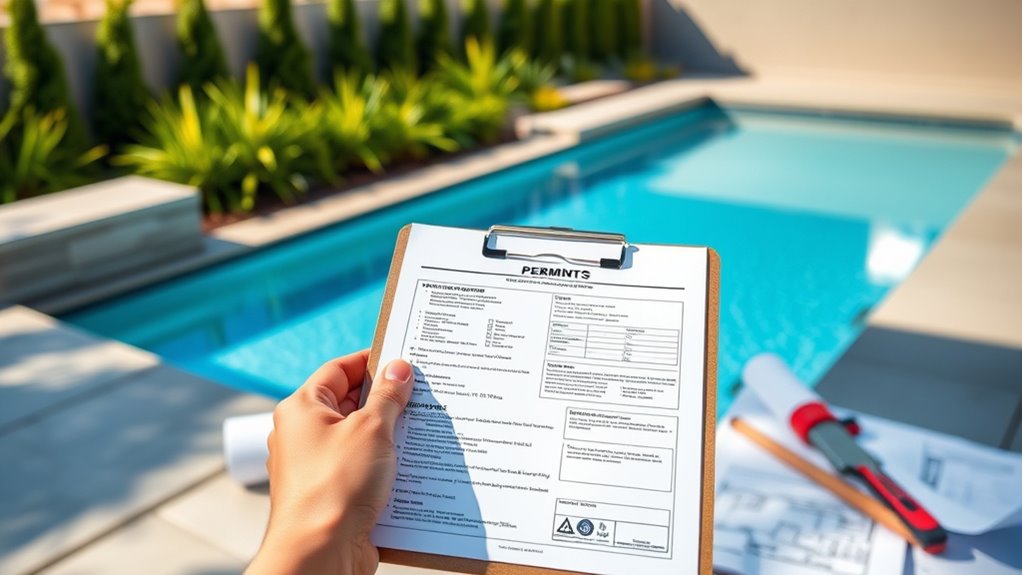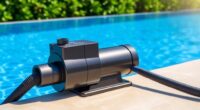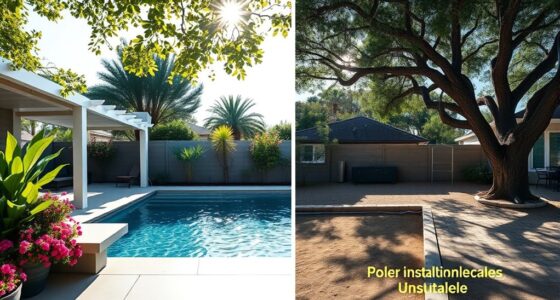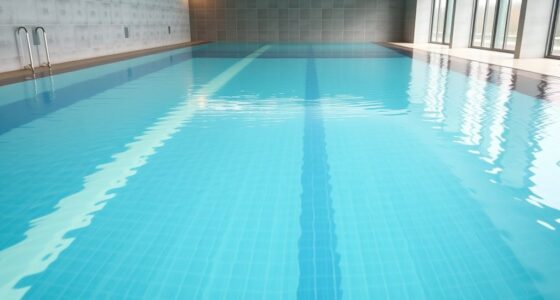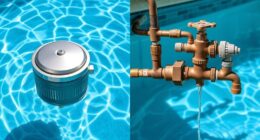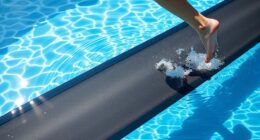Before installing an endless pool, you’ll need to check local zoning rules for setbacks, size, and safety fences. You might require a building permit, especially for larger or permanent setups. Make certain your electrical and plumbing systems meet safety codes with GFCI outlets and proper drainage. Safety standards like barriers, handrails, and accessibility should be followed. Don’t forget environmental concerns, including drainage permits. Understanding these requirements helps keep your project on track; learn more about the specifics ahead.
Key Takeaways
- Check local zoning regulations for pool placement, setbacks, and size restrictions specific to your area.
- Obtain necessary building permits for pools exceeding size or location thresholds before installation.
- Ensure compliance with electrical and plumbing codes, including GFCI outlets and proper drainage systems.
- Install safety features like fencing, barriers, and non-slip surfaces to meet safety standards and accessibility requirements.
- Coordinate with local authorities for environmental permits related to drainage and site impact assessments.
Understanding Local Zoning Regulations for Pool Installations
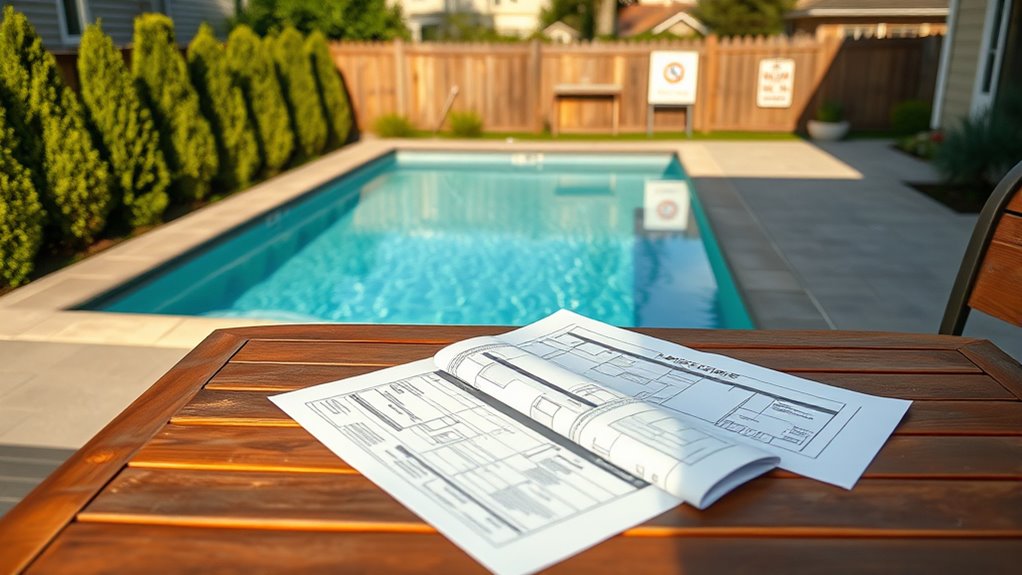
Understanding local zoning regulations is essential before installing a pool on your property. These rules determine where you can place your pool, how close it can be to property lines, and whether you need special setbacks or buffers. Zoning codes vary by city and neighborhood, so you should check with your local zoning office or review zoning maps. Some areas restrict pool placement near property boundaries or require fences and barriers for safety. Failing to comply can result in fines, forced removal, or delays. Make sure to understand any restrictions on pool size, height, or proximity to structures. Taking the time to learn these regulations upfront helps you avoid costly adjustments later and ensures your pool project runs smoothly. Additionally, understanding the local zoning ordinances related to pool installation can help you identify any hidden requirements that may apply specifically to your property.
Building Permits: When and Why You Need Them

You’ll need a building permit before starting your pool installation to guarantee it complies with local safety and construction standards. Typically, permits are required if your pool exceeds a certain size, is in a specific location, or if local regulations specify so. Getting the permit ensures your project meets structural, safety, and zoning requirements, helping you avoid fines or costly modifications later. Even if permits aren’t always mandatory for small or portable pools, applying for one is a smart move to stay compliant. It also provides documentation that your installation was approved by local authorities. Check with your city or county building department early to understand the specific requirements for your area. Securing the permit before starting saves time, money, and potential legal issues down the line. Understanding local regulations is crucial for a smooth installation process.
Electrical and Plumbing Code Requirements for Endless Pools

Ensuring your Endless Pool meets electrical and plumbing code requirements is essential for safety and compliance. Proper installation minimizes risks like electrical shocks or leaks, keeping your family safe. You’ll need to follow specific standards set by local codes and national safety agencies. These include using GFCI outlets for electrical connections, ensuring proper grounding, and installing waterproof or weatherproof wiring. For plumbing, you must use approved materials, ensure proper drainage, and install backflow prevention devices. It’s also important to verify that your plumbing setup accommodates filtration and water circulation needs. Staying compliant prevents future fines or costly modifications. To help, here are key points to consider:
Proper electrical and plumbing standards ensure your Endless Pool’s safety and compliance.
- Use GFCI outlets for electrical safety
- Proper grounding of electrical components
- Waterproof wiring and connections
- Approved plumbing materials and fittings
- Backflow prevention devices
- Properly designed water circulation and filtration systems to meet health standards
Safety Standards and Accessibility Regulations
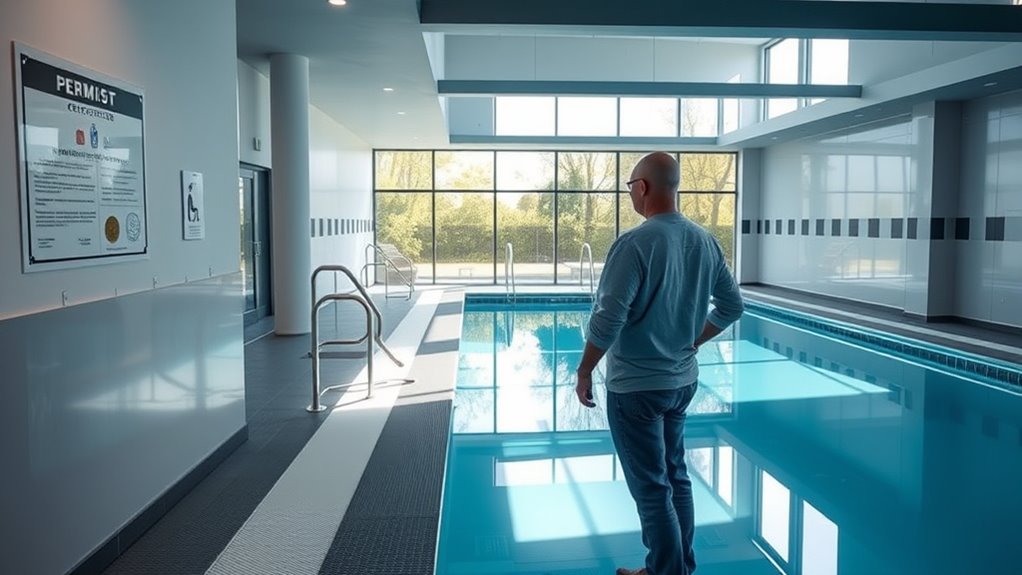
Are your safety standards and accessibility measures up to current regulations? Ensuring your Endless Pool complies is essential for safety and legal adherence. You need to install proper barriers or fencing to prevent accidental falls, especially if children or pets are nearby. Handrails and non-slip surfaces are necessary for safe entry and exit. Accessibility features, like ramps or widened pathways, may be required to accommodate users with mobility challenges. Local codes often specify minimum distances from electrical outlets, vents, and other hazards. Regular inspections and clear signage are also critical to promote safe use. Staying informed about building codes and regional requirements can help you avoid fines or installation delays. Meeting safety and accessibility regulations protects everyone and ensures your pool remains a secure, enjoyable space.
Environmental Considerations and Drainage Permits
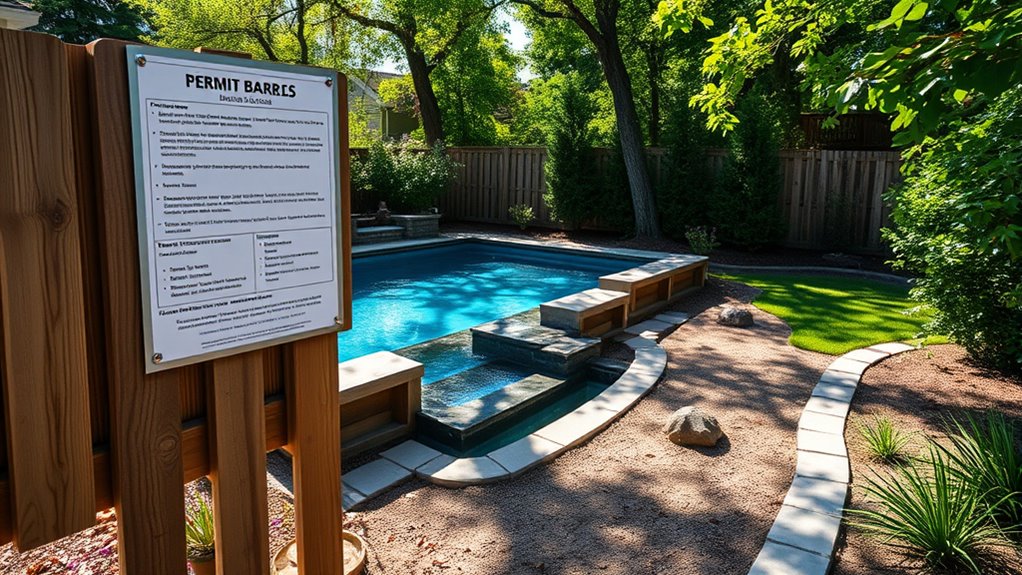
When planning your project, you need to contemplate site drainage requirements to prevent water issues and comply with regulations. Conducting environmental impact assessments helps identify potential effects on the surrounding ecosystem. Ensuring proper drainage and environmental reviews can save you time and avoid costly setbacks later on. Additionally, understanding signs of spoilage in materials used during installation can help maintain safety standards and prevent future complications.
Site Drainage Requirements
Site drainage requirements are critical to prevent erosion, manage stormwater runoff, and protect surrounding ecosystems. Proper drainage guarantees water flows away from your property and the pool area, avoiding flooding or damage. You’ll need to evaluate your site’s slope, soil type, and existing drainage patterns. Installing appropriate drainage systems, like swales or drains, helps direct water safely away. Local codes may specify setbacks from natural water bodies or require permits for grading work. It’s essential to coordinate with local authorities to meet drainage standards. Failure to comply can lead to fines or costly modifications later. Planning ahead ensures your pool installation won’t disrupt natural water flow or cause environmental issues. Good contrast ratio and proper drainage are both essential for ensuring your pool’s long-term stability and safety. Remember, good drainage benefits both your property and the environment.
Environmental Impact Assessments
Implementing proper drainage systems not only protects your property but also minimizes environmental impact. Before installing your endless pool, you should conduct an Environmental Impact Assessment (EIA) to identify potential effects on local ecosystems. This assessment helps you evaluate how your project might alter water flow, soil stability, or wildlife habitats. Many jurisdictions require an EIA to ensure environmental safety and compliance with regulations. You’ll need to gather data on drainage patterns, nearby water bodies, and existing vegetation. Based on findings, you may need to modify your plans or implement mitigation measures. Securing the necessary permits often hinges on completing an EIA. Additionally, understanding the drainage system is crucial to prevent issues like soil erosion or flooding. By proactively addressing environmental concerns, you help preserve the local environment and avoid costly delays or penalties.
Working With Contractors and Securing Inspections
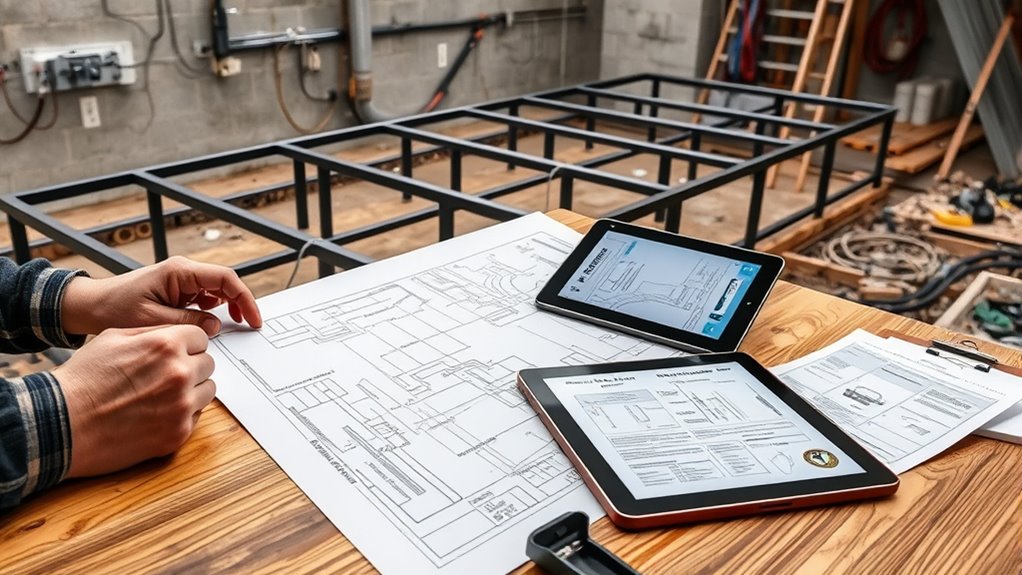
Working effectively with contractors and securing inspections is essential to ensuring your project stays on track and meets all code requirements. Clear communication helps prevent misunderstandings, delays, and costly rework. Make sure you thoroughly vet your contractor’s experience with pool installations and local codes. Schedule inspections early and stay involved throughout the process to address issues promptly. Keep detailed records of permits, approvals, and correspondence. Understand the inspection criteria so you can prepare accordingly. Maintaining a good working relationship with inspectors and contractors speeds up approvals and ensures compliance. Additionally, permitting process knowledge is crucial for navigating the necessary approvals smoothly.
- Confirm contractor licensing and insurance before starting
- Schedule inspections at key project milestones
- Keep all permits and documentation organized
- Clarify inspection requirements upfront
- Address issues immediately to avoid delays
Frequently Asked Questions
How Long Does the Permit Approval Process Typically Take?
The permit approval process usually takes between two to six weeks, depending on your local jurisdiction. You should submit your application promptly and make sure all necessary documents are complete to avoid delays. Stay in contact with your permitting office and respond quickly to any requests for additional information. Planning ahead helps you get approval faster, so you can proceed with your endless pool installation without unnecessary setbacks.
Are There Specific Noise Restrictions for Backyard Pools?
Yes, there are usually noise restrictions for backyard pools. Local ordinances often limit noise levels, especially during nighttime hours, to prevent disturbances to neighbors. You should check with your city or homeowner’s association for specific rules, as they can vary widely. To avoid issues, keep pool equipment like pumps and filters well-maintained and consider installing noise barriers if needed. Staying compliant helps make certain your pool remains a source of enjoyment without conflicts.
Can Permits Be Expedited for Urgent Installations?
Yes, permits can often be expedited if your installation is urgent. You should contact your local permitting office directly to explain your situation and ask about priority processing. Providing necessary documentation promptly and emphasizing the urgency can help speed things up. Keep in mind that approval times vary depending on your area’s regulations, so it’s best to start the process early and stay in close contact with officials.
What Are the Penalties for Non-Compliance With Local Codes?
If you don’t comply with local codes, you could face hefty fines, property liens, or even forced removal of your pool. These penalties might seem strict, but they’re in place to ensure safety and proper installation. To avoid trouble, follow all regulations carefully and obtain necessary permits. Staying compliant protects your investment and lets you enjoy your pool without worry. Remember, adhering to rules benefits everyone involved.
Do Permits Cover Both Electrical and Plumbing System Inspections?
Yes, permits typically cover both electrical and plumbing system inspections. When you apply for a permit, inspectors will verify that your electrical wiring meets safety standards and that your plumbing connections are properly installed. This guarantees your endless pool operates safely and efficiently. You should schedule inspections accordingly, and if any issues are found, you’ll need to address them before completing your project and obtaining final approval.
Conclusion
Guiding permits and codes is like charting a course through a well-lit path, guiding you safely to your backyard oasis. By understanding regulations, you’re planting the seeds for a secure, lasting haven—your personal sanctuary of relaxation. Think of each permit as a key opening peace of mind, ensuring your endless pool becomes a symbol of joy and harmony. With proper planning, your dream retreat will flourish, standing as a proof of care and compliance.
